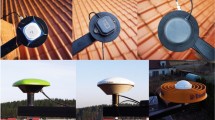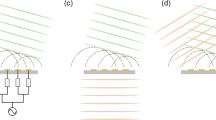Abstract
This paper compares the performance and complexity of two methods of steering an array of aperture antennas on a high altitude platform for the provision of broadband fixed wireless access using cellular type frequency reuse. The first method is to steer all antennas individually to maintain the boresight at the required cell centre. The paper also presents a second method of compensating for aperture antenna pointing error due to lateral and vertical displacement of the platform from the nominal station using only four actuators plus a gimbal that can correct for roll, pitch and yaw of the platform. Results for signal strength, CIR and handovers are given for both scenarios and conclusions drawn.
Similar content being viewed by others
References
D. Grace, N.E. Daly, T.C. Tozer, A.G. Burr, and D.A.J. Pearce, “Providing Multimedia Communications from High Altitude Platforms”, International Journal of Satellite Communications, Vol. 19, No. 6, pp. 559–580, November 2001.
G.M. Djuknic, J. Freidenfelds, and Y. Okunev, “Establishing Wireless Communications Services Via High-Altitude Aeronautical Platforms: A Concept Whose Time Has Come?”, IEEE Communications Magazine, Vol. 35, No. 9, pp. 128–35, September 1997.
N.J. Collela, J.N. Martin, and I.F. Akyildiz, “The HALO Network™”, IEEE Communications Magazine, Vol. 38, No. 6, pp. 142–148, June 2000.
D. Grace, J. Thornton, T. Konefal, C. Spillard, and T.C. Tozer, “Broadband Communications from High Altitude Platforms – The HeliNET Solution”, in Wireless Personal Multimedia Communications (WPMC) 2001, Aalborg, Denmark, pp. 75–80, 9–12 September 2001.
International Telecommunications Union, “Preferred Characteristics of Systems in the FS Using High Altitude Platforms Operating in the Bands 47.2–47.5 GHz and 47.9–48.2 GHz”, Recommendation ITU-R F.1500, 2000.
B. El-Jabu and R. Steele, “Cellular Communications Using Aerial Platforms”, IEEE Transactions on Vehicular Technology, Vol. 50, No. 3, pp. 686–700, May 2001.
J. Thornton and D. Grace, “Effect of Lateral Displacement of a High Altitude Platform on Cellular Interference and Handover”, IEEE Transactions on Wireless Communications, April 2004, in press.
Y. Albagory, “Investigating the Rotational Motion Effects of High Altitude Platforms on Mobile Communications”, in Proceedings of SoftCOM 2002, pp. 521–525, 8–11 October 2002.
R. Miura and M. Oodo, “Wireless Communications System Using Stratospheric Platforms”, Journal of the Communication Research Laboratory, Vol. 48, No. 4, pp. 33–48, 2001.
J.-M. Park, B.-J. Ku, Y.-S. Kim, and D.-S. Ahn, “Technology Development for Wireless Communications System Using Stratospheric Platform in Korea”, IEEE PIMRC 2002, September 2002.
R. Miura, M. Oodo, and Y. Hase, “Development of Multibeam Antennas in Millimeter-Wave Band on Board Stratospheric Platform”, in Conference on Antennas & Propagation (AP2000), Davos, Switzerland, 9–14 April, 2000.
J. Thornton, D. Grace, M.H. Capstick, and T.C. Tozer, “Optimising an Array of Antennas for Cellular Coverage from a High Altitude Platform”, IEEE Transactions on Wireless Communications, Vol. 2, No. 3, pp. 484–492, May 2003.
J. Thornton, “A Low Sidelobe Asymmetric Beam Antenna for High Altitude Platform Communications”, IEEE Microwave and Wireless Components Letters, Vol. 14, No. 2, pp. 59–61, February 2004.
J. Thornton and D. Grace, “Effect of Antenna Aperture Field on Co-Channel Interference, Capacity and Payload Mass in High Altitude Platform Communications”, ETRI Journal, Vol. 26, No. 5, pp. 467–474, October 2004.
Author information
Authors and Affiliations
Corresponding author
Additional information
Myles Capstick received his B.Sc and Ph.D degrees in Electronics from the University of Wales, Bangor, in 1987 and 1991, respectively. His current position is as a Senior Lecturer at the University of York and he has also been a Lecturer at the University of Wales in Bangor and at York. His research interests are centred in RF, microwave and mm-wave circuits and systems. More specifically, mm-wave and microwave filters, diplexers and planar array antennas and the design and modelling of broadband, multiband and compact antennas for MIMO communication. He has particular expertise in the area of EMC for RF and microwave circuits and systems, research that extends into the design of the dosimetry equipment for human exposure to EM fields used in human volunteer trials within the UK’s Human Health and Mobile Telecommunications Research programme. He has been an invited speaker at several conferences and seminars in the fields of mobile communications and EMC. He is a member of the IEE.
David Grace received his M.Eng degree in Electronic Systems Engineering D.Phil degree from the University of York, UK in 1993 and 1999, respectively. His D.Phil thesis dealt with ‘Distributed Dynamic Channel Assignment for the Wireless Environment’. Since 1994 he has been a member of the Communications Research Group at York, where he is now a Research Fellow. He has worked on a variety of research contracts including several from the former Defence Evaluation and Research Agency. Current research interests include radio resource management for broadband communications, particularly from high-altitude platform and terrestrial ad hoc networks. He is now Principal Scientific Officer for CAPANINA a major European Framework 6 project that is developing broadband communications from high-altitude platforms. He has been an invited speaker at several conferences and industrial locations in the fields of HAP systems. He is also a nominated Researcher in the European NEWCOM Network of Excellence, and a Director of SkyLARC Technologies Ltd, a York based company, specialising in broadband communications from aerial platforms. He is a member of IEE and IEEE.
Rights and permissions
About this article
Cite this article
Capstick, M.H., Grace, D. High Altitude Platform mm-Wave Aperture Antenna Steering Solutions. Wireless Pers Commun 32, 215–236 (2005). https://doi.org/10.1007/s11277-005-0743-2
Issue Date:
DOI: https://doi.org/10.1007/s11277-005-0743-2




